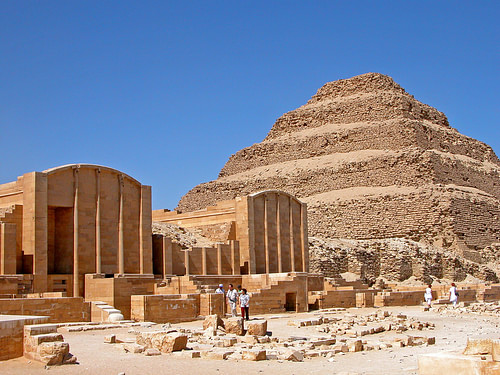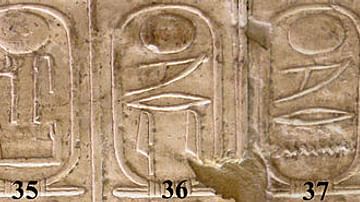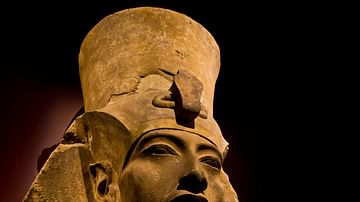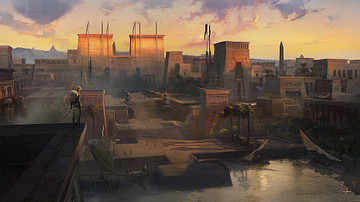
The Pharaoh in ancient Egypt was the political and religious leader of the people and held the titles 'Lord of the Two Lands' and 'High Priest of Every Temple'. The word 'pharaoh' is the Greek form of the Egyptian pero or per-a-a, which was the designation for the royal residence and means `Great House'.
The name of the residence became associated with the ruler and, in time, was used exclusively for the leader of the people. The early monarchs of Egypt were not known as pharaohs but as kings. The honorific title of `pharaoh' for a ruler did not appear until the period known as the New Kingdom (c.1570-c.1069 BCE). Monarchs of the dynasties before the New Kingdom were addressed as `your majesty' by foreign dignitaries and members of the court and as `brother' by foreign rulers; both practices would continue after the king of Egypt came to be known as a pharaoh.
The Kingship is Established
In 3150 BCE the First Dynasty appeared in Egypt with the unification of Upper and Lower Egypt by the king Menes (c. 3150 BCE, now believed to be Narmer). Menes/Narmer is depicted on inscriptions wearing the two crowns of Egypt, signifying unification, and his reign was thought to be in accordance with the will of the gods; but the office of the king itself was not associated with the divine until later.
During the Second Dynasty of Egypt (2890-2670 BCE) King Raneb (also known as Nebra) linked his name with the divine and his reign with the will of the gods. Following Raneb, the rulers of the later dynasties were equated with the gods and with the duties and obligations due to those gods. Chief among these was the maintenance of ma'at - harmony and balance - which had been decreed by the gods and needed to be observed in order for people to live the best possible life.
Osiris was considered the first "king" of Egypt and so earthly rulers honored him, and established their own authority, by carrying the crook and the flail. The crook stood for kingship (guidance of the people) while the flail was associated with the fertility of the land (threshing wheat). The crook and flail were associated with an early powerful god named Andjety who came to be absorbed by Osiris. Once Osiris was established in tradition as the first king, he son Horus also came to associated with a pharaoh's reign.
The cylindrical objects sometimes seen in the hands of statues of Egyptian monarchs are known as the Cylinders of Pharaoh and the Rods of Horus and are thought to have been used to focus one's spiritual and intellectual energy - much in the way someone today might use Rosary Beads or Komboloi (worry beads).
As supreme ruler of the people, the pharaoh was considered a god on earth, the intermediary between the gods and the people. When the pharaoh came to the throne he was instantly associated with Horus - the god who had defeated the forces of chaos and restored order - and when he died, he was associated with Osiris, the god of the dead.
As such, in his role of 'High Priest of Every Temple', it was the pharaoh's duty to build great temples and monuments celebrating his own achievements and paying homage to the gods of the land who gave him the power to rule in this life and would guide him in the next.
Additionally, the pharaoh would officiate at religious ceremonies, choose the sites of temples and decree what work would be done (although he could not choose priests and very rarely took part in the design of a temple). As 'Lord of the Two Lands' the pharaoh made the laws, owned all the land in Egypt, collected taxes, and made war or defended the country against aggression.
The rulers of Egypt were usually the sons or declared heirs of the preceding pharaoh, born of the Great Wife (pharaoh's chief consort) or sometimes a lesser-ranked wife whom the pharaoh favored. Early on, the rulers married female aristocrats in an effort to establish the legitimacy of their dynasty by linking it to the upper classes of Memphis, which was then Egypt's capital.
This practice may have begun with Narmer, who established Memphis as his capital and married the princess Neithhotep of the older city of Naqada to consolidate his rule and link his new city to Naqada and his home city of Thinis. To keep the blood-line pure, many pharaohs married their sisters or half-sisters and Pharaoh Akhenaten married his own daughters.
The Pharaoh and Ma'at
The chief responsibility of the pharaoh was to maintain ma'at throughout the land. The goddess Ma'at (pronounced 'may-et' or 'my-eht') was thought to provide harmony through the pharaoh but it was up to the individual ruler to interpret the goddess' will correctly and to then act on it.
Accordingly, warfare was an essential aspect of the rule of pharaoh, especially when it was seen as necessary for the restoration of balance and harmony in the land. This concept of war is exemplified in The Poem of Pentaur, written by the scribes of Rameses II, the Great (r. 1279-1213 BCE), regarding his victory over the Hittites at the Battle of Kadesh in 1274 BCE.
The Hittites, according to Ramesses II, had disrupted the balance of Egypt and so needed to be dealt with severely. The pharaoh had a sacred duty to defend the borders of the land, but also to attack neighboring countries for natural resources if it was thought that this was in the interest of harmony.
Pharaohs and the Pyramids
By the 3rd dynasty King Djoser (r. c. 2670 BCE) commanded enough wealth, prestige and resources to have the Step Pyramid built as his eternal home. Designed by the vizier Imhotep (l. c. 2667-2600 BCE), the Step Pyramid was the tallest structure of its day and a very popular tourist attraction then, as it is today. The pyramid was designed primarily as Djoser's final resting place but the splendor of the surrounding complex and great height of the pyramid were intended to honor not only Djoser but Egypt itself and the prosperity of the land under his reign.
Other 3rd Dynasty kings such as Sekhemkhet and Khaba built pyramids following Imhotep's design (the Buried Pyramid and the Layer Pyramid) and created a type of monument which would become synonymous with Egypt even though the pyramid structure was used by many other cultures (notably the Maya, who had no contact at all with ancient Egypt). Old Kingdom monarchs (c. 2613-2181 BCE) then followed suit culminating in the Great Pyramid at Giza, immortalizing Khufu (r. 2589-2566 BCE) and making manifest the power and divine rule of the pharaoh in Egypt.

The 18th Dynasty and Egypt's Empire
With the collapse of the Middle Kingdom in 1782 BCE, Egypt came to be ruled by the mysterious Semitic people known as the Hyksos. The Hyksos, however, emulated all the trappings of the Egyptian pharaohs and kept the customs alive until their kingdom was overthrown by the royal line of the Egyptian 18th Dynasty which then gave rise to some of the most famous of the pharaohs such as Rameses the Great and Amenhotep III (r. 1386-1353 BCE).
This was the period of Egypt's empire and the prestige of the pharaoh was never greater. Egypt controlled the resources of regions from Mesopotamia down through the Levant, across to Libya, and further south into the Nubian Kingdom of Kush. When Ahmose I (r. c.1570-1544 BCE) drove the Hyksos from Egypt, he established buffer zones around the borders so that no other invasive people could gain a foothold inside Egypt. These zones were eventually fortified and goverened by Egyptian administrators who would report to the pharaoh.
These pharaohs were predominantly male but Queen Hatshepsut (r. 1479-1458 BCE) of the 18th Dynasty ruled successfully as a female monarch for over twenty years and, during her reign, Egypt prospered. She re-established trade with the Land of Punt and encouraged trade expeditions elsewhere which caused the economy to boom. Hatshepsut was responsible for more public works projects than any pharaoh save Rameses II and her rule is marked by peace and affluence throughout the land.
When Tuthmose III (r. 1458-1425 BCE) came to power after her, he had her image removed from all her temples and monuments in an effort, it is thought, to restore order to the land. According to tradition, a woman should never have held the title of the pharaoh - that was an honor reserved for males in keeping with Osiris as the first king of Egypt and his sister Isis as his consort, not reigning monarch. It is thought, then, that Thutmose III feared Hatshepsut's example might inspire other women to 'forget their place' in the sacred order and aspire to power the gods had reserved for males.
Decline of the Pharaoh
The New Kingdom was the period of Egypt's greatest success on many levels but it could not last. The power of the pharaoh began to decline after the reign of Ramesses III (r. 1186-1155 BCE) during which the Sea Peoples had invaded. The cost of the Egyptian victory over the Sea Peoples, both financial and in lives lost, was considerable and Egypt's economy began to decline.
The first labor strike in history also occurred under Ramesses III which called into question this pharaoh's ability to maintain ma'at and how much the upper classes actually cared for the people. A number of other factors also contributed to the end of the New Kingdom that ushered in the Third Intermediate Period (c. 1069-525 BCE) which concluded with the Persian invasion.
The prestige of the pharaoh waned considerably after the defeat of the Egyptians by the Persians at the Battle of Pelusium in 525 BCE and, still further, after the conquests of Alexander the Great. By the time of the last pharaoh, the well-known Cleopatra VII Philopator (l. c. 69-30 BCE) of the Ptolemaic Dynasty, the title no longer held the power it once did, fewer monuments were erected and, with her death in 30 BCE, Egypt became a Roman province and the glory and might of the pharaohs of old faded into memory.











